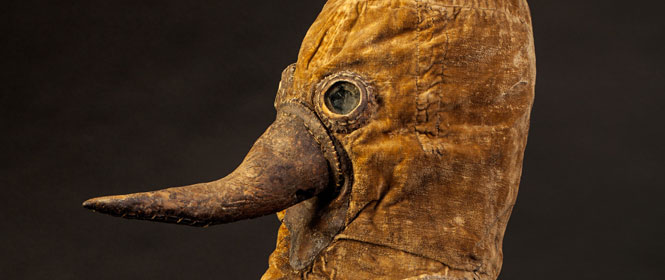
Beaky Plague Protection
People in white protective suits, carefully making their way through a sealed-off area in which a deadly virus rages – no, this is not the beginning of a post-apocalyptic horror scenario or dystopia. Such images are familiar, appearing most recently in relation to the Ebola epidemic. Suits like this, however, were already in use a few hundred years ago, designed to protect their wearers against the plague and other illnesses. In our series What’s That For? we explain how the plague doctor’s costume was used in the battle against devastating diseases.
For a long time no-one knew how the plague was transmitted. Proposed causes included an unfavourable conjunction of Mars, Jupiter, and Saturn, or contaminated water. People assumed that ‘bad winds’ and foul air, called ‘miasma’, spread the illness. For this reason only windows facing north were considered safe for ventilation. Essential oils and other aromatic essences were used to repel the poisoned ‘plague air’.
To protect themselves from highly contagious diseases doctors wore protective hoods like the plague mask from our permanent exhibition. The face was completely covered by a cotton velvet mask and the wearer breathed through two small holes in the ‘beak’, which held herbs or sponges soaked in vinegar. These were believed to filter the air and repel disease. Glass lenses covered the eyes to ward off the patient’s gaze, in case the illness spread by eye-contact. The plague mask was coated with a layer of wax on the inside and came with a cloak-like leather costume to cover the entire body, forming a protective suit comparable to those used today in the isolation wards of modern hospitals.
In the Middle Ages doctors tried to expel the plague from the body by letting blood or inducing vomiting, both of which usually weakened the patients further. Many people fled plague-ridden areas, which spread the epidemic even faster. It was not until the middle of the 15th century, after the epidemic had reached its peak, that the first quarantine stations were established on the Venetian island Lazzaretto Nuovo. Here travellers were held under observation for 40 days before being allowed to continue their journey.
The exact number of plague victims remains unknown, but estimates range between 20 and 50 million. The true cause of the plague was first discovered in 1894 by the physician and bacteriologist Alexandre Yersin. The pathogen, Yersinia pestis, now bears his name. It was carried by rats and transmitted to people by flees.